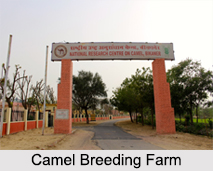 Established in the year 1984 by the central government, the Camel Breeding Farm is located in the Jorbeer region and was founded by the Indian Council of Agricultural Research. Camel constitutes the vital species of the desert ecosystem and is known to be the Ship of the Desert. The city of Bikaner is the residence of camel breeding and is the true representative of the single humped Indian camels.
Established in the year 1984 by the central government, the Camel Breeding Farm is located in the Jorbeer region and was founded by the Indian Council of Agricultural Research. Camel constitutes the vital species of the desert ecosystem and is known to be the Ship of the Desert. The city of Bikaner is the residence of camel breeding and is the true representative of the single humped Indian camels.
History of Camel Breeding Farm
Camels are indispensable as a mode of transportation, a reservoir of fatty tissue and can go on without water for long periods of time along with many other utilities which are subject to continuous social and economic changes. Since time immemorial, camels have known to play a significant role in the civil law and order, battles and defences of the country. In the First and Second World Wars, the Bikaner Camel Corps, an erstwhile army regiment that was initially raised as the Ganga Risala unit operated under the Imperial Service Troops and served along with the British Indian Army. Currently, the Camel Corps constitute an important wing of the Border Security Force of Indian Para-Military Services.
 Thus, considering the importance of camel in the socio-economic development of arid and semi-arid zones, the Government of India established a Project Directorate on Camel at Bikaner on 5th July, 1984 under the aegis of Indian Council of Agricultural Research which was upgraded to National Research Centre on Camel on September 20th, 1995. This centre which is also known as the Camel Breeding Farm mainly focuses on the basic and applied research on one humped camel and focuses on issues relating to the double humped camel in the cold desert of Nubra Valley of Ladakh region.
Thus, considering the importance of camel in the socio-economic development of arid and semi-arid zones, the Government of India established a Project Directorate on Camel at Bikaner on 5th July, 1984 under the aegis of Indian Council of Agricultural Research which was upgraded to National Research Centre on Camel on September 20th, 1995. This centre which is also known as the Camel Breeding Farm mainly focuses on the basic and applied research on one humped camel and focuses on issues relating to the double humped camel in the cold desert of Nubra Valley of Ladakh region.
Tourism in Camel Breeding Farm
The Camel Breeding Farm of Bikaner offers a unique experience to the tourist and shows why the city of Bikaner is often referred to as the camel country as the camels form an integral part of the city"s culture. The Camel Breeding Farm also has a museum that displays the history of the centre, its origin, recent initiatives and developments. There are around 400 camels at the Camel Breeding Farm along with an on-site camel milk parlour, where the tourists can enjoy ice-creams made of camel"s milk and take rides on its back. This government managed farm is one of the largest Camel Breeding Farms in Asia and raises the finest riding camels in the world.
Other than the breeding farm there is also the annual camel festival which reflects the long association of the animal with the dwellers. This is one festival where one can witness the Ship of the Desert dressed up in colourful attires and is an ideal event for those who wish to witness Rajasthan in its full colourful glory.
Visiting Information on Camel Breeding Farm
The Bikaner Junction is the nearest railway station at a distance of 9km from the Camel Breeding Farm. While the Jodhpur Airport is the closest at a distance of 248 km from the breeding farm and via roadways Bikaner is well connected with all the other major cities via National and State Highways.



















